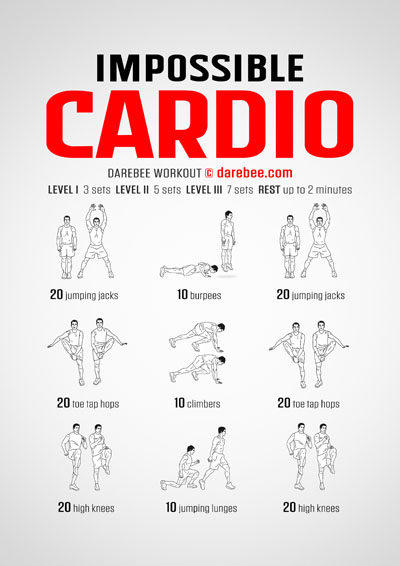Agencia 92: Your Source for Trending News
Stay updated with the latest insights and stories that matter.
Cardio Chaos: Sweat Now, Applaud Later
Unleash your inner athlete with Cardio Chaos! Dive into sweaty challenges and celebrate your transformation—your body will thank you!
5 Benefits of High-Intensity Cardio Workouts
High-intensity cardio workouts are an excellent way to maximize your fitness in a minimal amount of time. One of the primary benefits is their ability to boost metabolism. Engaging in high-intensity workouts stimulates the body to burn calories long after the workout is completed, a phenomenon known as excess post-exercise oxygen consumption (EPOC). This means that even when you're at rest, your body continues to burn more calories than it would after a moderate workout.
Another significant advantage of high-intensity cardio is the improvement in cardiovascular health. Regularly performing these workouts enhances heart efficiency, increases lung capacity, and improves overall stamina. Additionally, studies have shown that high-intensity training can significantly reduce the risk of heart disease, making it a crucial aspect of a well-rounded fitness regime. Integrating high-intensity cardio into your weekly routine can lead to impressive health benefits and help you achieve your fitness goals faster.

How to Create a Balanced Cardio Routine: Tips and Techniques
Creating a balanced cardio routine is essential for improving cardiovascular fitness while minimizing the risk of injury. Start by assessing your current fitness level and identifying your goals. For beginners, a combination of low-impact activities such as walking, cycling, or swimming can be effective. Aim to include at least 150 minutes of moderate-intensity or 75 minutes of vigorous-intensity cardio each week, breaking it down into manageable sessions. For example, you might schedule three 30-minute sessions of brisk walking and two 20-minute sessions of cycling to keep your routine varied and engaging.
In addition to duration and intensity, incorporating a variety of exercises can help create a balanced cardio routine. Consider alternating between different forms of cardio, such as running, interval training, and group classes. Cross-training not only enhances overall fitness but also prevents boredom and engages different muscle groups. Don't forget the importance of rest days; they allow your body to recover and adapt. As you become more comfortable with your routine, gradually increase the intensity or duration to continue making progress and avoid plateaus.
Cardio Myths Debunked: What You Really Need to Know
When it comes to cardio, many myths have persisted over the years, leading individuals to make decisions based on misinformation. One common myth is that longer cardio sessions are always better for weight loss. In reality, shorter, high-intensity workouts can be just as effective, if not more so, for burning calories and improving cardiovascular health. Studies have shown that incorporating interval training into your routine not only saves time but can also lead to increased fat loss and muscle preservation.
Another prevalent myth is that you must work out for hours to see results. The truth is, even brief periods of cardio can yield significant benefits. Just 20-30 minutes of moderately intense aerobic exercise, such as brisk walking or cycling, can enhance cardiovascular fitness and boost metabolism. Additionally, this myth can lead to the misconception that cardio alone is enough for a complete fitness routine; however, it's essential to incorporate strength training to build and maintain muscle mass, which plays a vital role in overall health and weight management.